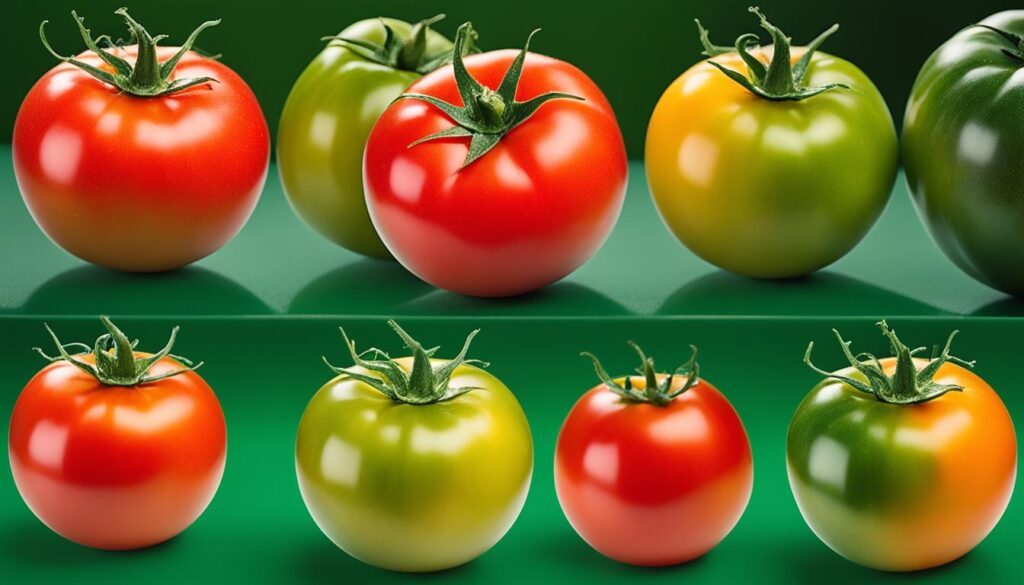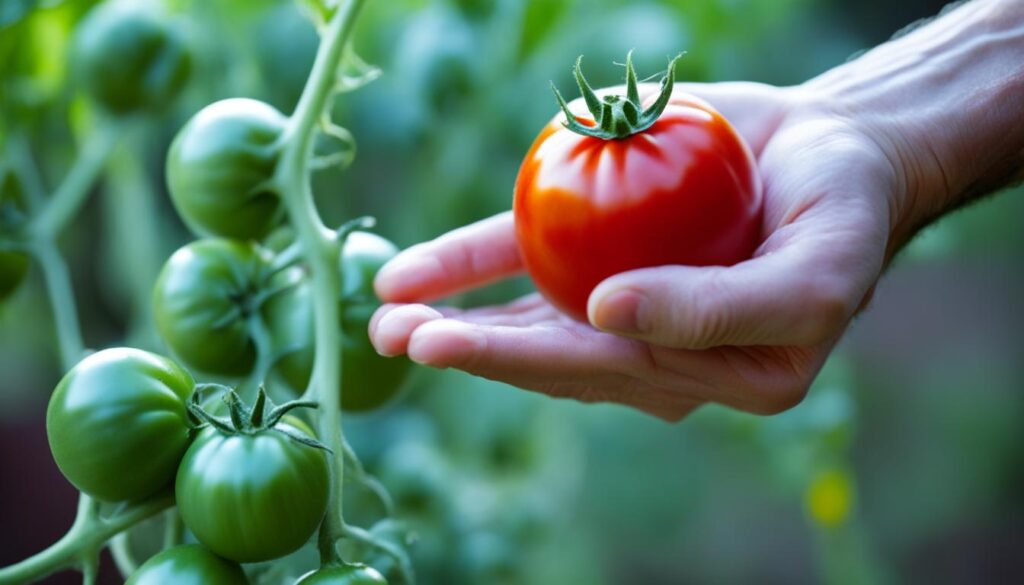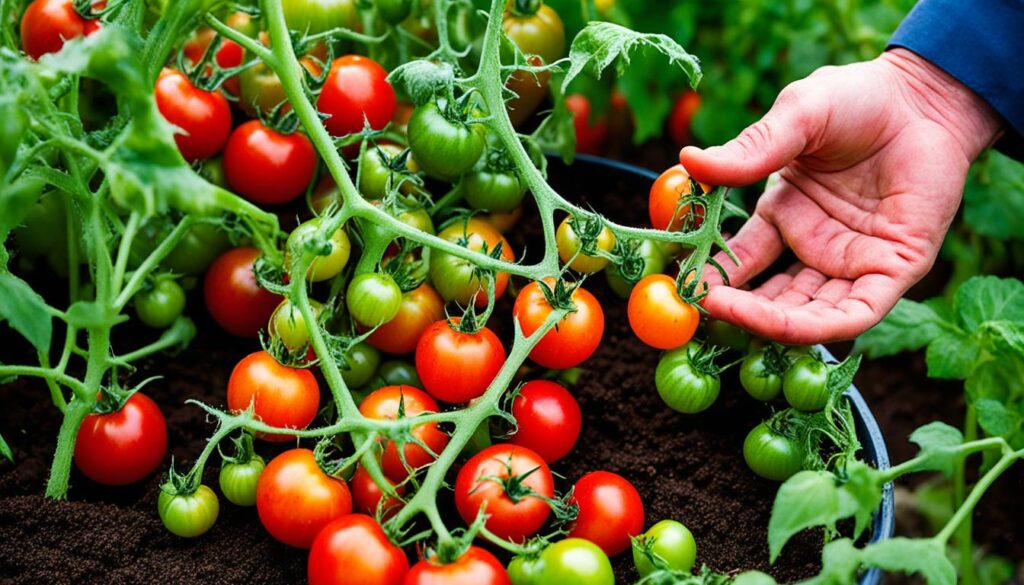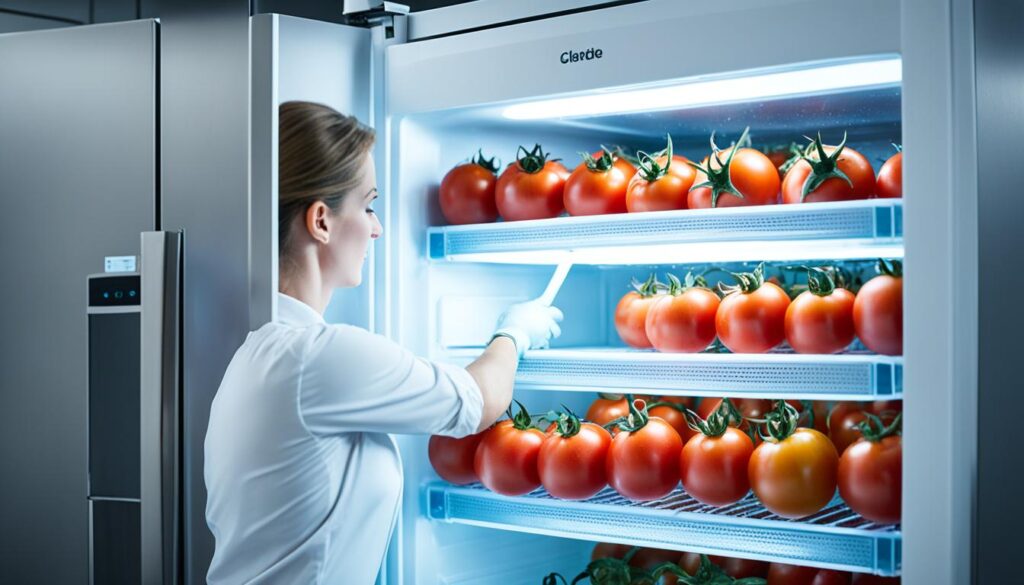Tomatoes are much loved by home gardeners. There are over 7,500 types to pick from.
Whether you grow them or get them from a local spot, eating that first ripe tomato is exciting. The variety of tomatoes, with heirloom and hybrid types, comes in many colors and shapes.
This makes the harvest even more thrilling. Tomatoes are seen as a fruit by scientists, but used as a veggie. Understanding the kind you’re growing can guide you on when to pick them.
Key Takeaways
- Tomatoes ripen first at the bottom, furthest from the plant
- Ethylene gas is released to signal the ripening process
- Tomatoes ripen at the same speed whether on or off the vine
- Supermarket tomatoes are picked before ripe for safe transportation
- Fridge cooling can effectively slow down tomato ripening
Introduction to Tomato Varieties
There are many tomato varieties you can find in seed catalogs. They give gardeners lots of choices.
Some tomatoes are great for containers, others for the ground.
Also, there are those needing support and some that don’t. You can find tomatoes in different colors, shapes, and sizes. They vary in the time it takes to grow, in their ability to fight off diseases, and in flavors too.
Heirloom vs. Hybrid Tomatoes
Heirloom and hybrid tomatoes are different. The main difference is how they’re made.
Heirlooms have a long history and have not been mixed with other tomatoes for at least 50 years, Hybrids, on the other hand, have been carefully created to combine the best features. These features might be more tomatoes, keeping away diseases, or special tastes.
Diversity in Colors, Shapes, and Sizes
A list of the author’s top tomato varieties is shared. It includes both heirloom and hybrid types. You can find red, purple, yellow, and even tomatoes with many colors. There are also paste, cherry, and special tomatoes. Each type is different in shape, size, and flavor.
Do you like classic beefsteak tomatoes or more colorful heirlooms? Tomatoes come in many kinds, offering fun choices for gardeners. Learning about different tomato plant types helps pick the best for your garden and kitchen.
Stages of Tomato Ripening
Tomato ripening is fascinating. It happens in several stages, each with unique features. There are six main stages, according to the Organic Farming and Gardening School.
Green Mature Stage
In the Green Mature Stage, the inside of the fruit shows some color. Yet, the outer skin is not colorful yet. The flavor is not rich at this point. The tomato is still gaining sugars and other tasty compounds.
Breaker Stage
At the Breaker Stage, the tomato’s end starts to show color. This means ethylene is working its magic. Ethylene is a natural ripening agent.
Turning Stage
The Turning Stage shows 10-30% of the skin turning pink or red. This signals the next ripening phase.
Pink Stage
Next is the Pink Stage. Here, 30-60% of the tomato is pink or red. The fruit also gets softer.
Light Red Stage
In the Light Red Stage, 60-90% of the tomato turns red. Its color deepens as it ripens more.
Red and Final Stage
The Red and Final Stage is when 90% of the tomato is red. This is a sign it’s ready to pick and eat right from the vine.
Tomatoes keep ripening after they are picked. At the Breaker Stage, they can be picked to prevent damage. This way, they still get a taste like they ripened on the vine.
Signs to Watch for When to Harvest Tomatoes
To know when to pick your tomatoes, keep an eye out for signs. Look for color changes and check the firmness of the fruit. Each type of tomato may show different signs of being ready. This knowledge will help you pick when they are at their best.
Color Changes
The color change of tomatoes shows they are becoming ripe. It starts with a blush at the blossom-end then turns pink, light red, and finally the classic red color. Watch for these skin color changes to pick them at the right time.
Fruit Firmness
How firm the tomatoes are is also a clue they are ready. Ripe tomatoes are a little tender and supple to the touch. If they feel squishy or hard, they’re not ready yet. Try a touch test to see if they’re ripe.
Varietal Differences
Keep in mind, tomato varieties can differ a lot. They vary in size, look, and how quickly they ripen. Some types are ready in 42 days, while others take up to 110 days. Learning about your specific tomato plants is key. It helps you know when they are ripe.
Watching for these signs will help you harvest your tomatoes perfectly. This way, you’ll get the best flavor and quality from your homegrown tomatoes.

When to Harvest Tomatoes?
Gardeners often wonder about the best time to pick tomatoes. Tomatoes are ripe at the Breaker Stage. But, most believe waiting for that rich, red color makes them tastier.
The prime time is late summer to early fall. This is before the first frost and while it’s still warm. Yet, the right time to pick can change based on where you are and the type of tomatoes you grow.
Tomatoes require regular watering, at least 1 inch a week, to grow well. This keeps them from splitting.
Inconsistent watering can cause a tomato’s skin to crack. This happens if the outside grows too fast. After a heavy rain, they might also split if they were dry before. Mulch helps to keep the soil moist, protecting them from sudden weather changes.
If a tomato does split, it can still be eaten. Just make sure it’s not been damaged by bugs. While you can use them in dishes, they won’t last as long.
Optimal Timing for Harvesting
The best time to pick tomatoes is in late summer to early fall. This is when they are ripe and safe from bad weather. The first source says this lets the fruit ripen fully without harm from storms or sun. It also prevents over-ripening in extreme heat over 85°F. The third source adds that you should harvest before the first frost. The exact time depends on your local weather and tomato type.
Late Summer to Early Fall
Pick your tomatoes before the first frost to get the best yield and taste. Late summer to early fall is perfect for tomatoes to get sweet and ripe.
Before the First Frost
It’s key to harvest before the season’s first frost hits. The cold can harm your tomatoes. Picking them in late summer or early fall keeps them safe and ensures a good harvest.

Harvesting Techniques
A proper way to harvest tomatoes keeps them in good shape. The advice is from a trusted source. You should be very gentle. Handle the tomatoes carefully to avoid hurting them. The best way is to hold the vine, then the tomato itself, and pull gently.
Handling Tomatoes Gently
Tomatoes are very soft and can be hurt easily. To pick them right, take the vine and then the tomato. Pull or twist it off softly. This way, you keep the tomato from getting damaged. You won’t see any bruises or tears.
Pulling from the Vine
It’s best to pull or twist tomatoes off the vine with care. This method helps you pick them without harm. Also, early mornings are perfect for picking. Tomatoes are still dewy, which stops them from getting too ripe too fast.

Extending Shelf Life
Tomatoes give us 40% of our daily vitamin C, but they don’t last long. They’re quick to spoil after picked because they’re soft and easily infected. Tomatoes we like, the light and deep red ones, spoil fast. But, there are tricks to keep them fresh longer.
Refrigeration
To keep tomatoes longer, refrigerate them. Cooling tomatoes right after picking, between 13-20°C, slows their spoilage. Keeping them in a cool place, between 10-15°C, and humid, 85-95%, helps them not get too ripe too soon.
But, remember, don’t put them in a fridge below 10°C to avoid spoilage.
Ethylene Gas and Ripening
Tomatoes ripen off the vine with the help of ethylene gas. To make them last longer, pick them a bit early. Then, let them ripen at their own pace, releasing ethylene as they go. Using 1-MCP spray at 0.5μl l-1 for a day can also stop them from ripening quickly.

After picking, handle tomatoes right. Clean the cold storage rooms often and keep them aired out. Also, warm up the tomatoes a bit before they leave the cold room to avoid wetness, which can cause them to spoil.
Garden Planning for Tomato Harvest
Tomato harvesting starts with good garden planning and prep work. Adding compost or manure to the soil is key. This feeds the plants and keeps the soil a good pH, between 6.0 and 6.8. Tomatoes thrive in this environment.
Soil Preparation
Getting the soil ready is a vital first step in planning for a great tomato crop. Using organic material helps the soil hold water better. It makes nutrients easier for the plants to use. This all leads to healthier plants.
Planting and Spacing
The way you plant and space your tomato seedlings impacts their growth and how much they yield. Plant them at the right depth and space, about 2-3 feet apart. This setup is good for the plants’ health and lets them grow freely. Good planning in these areas leads to more tomatoes.
Pruning and Staking
Tomato plants need support to grow well. Staking and pruning help with this. It boosts air flow, stops disease, and helps the fruits get enough sun. All this makes for healthier plants and more tomatoes.
By following these strategies, you prepare for a big, healthy tomato harvest.
Preserving and Enjoying Your Harvest
Have you grown lots of tomatoes? Or do you have many fresh fruits? You can use these tasty gems in many ways. Enjoy them in salads and sandwiches. Or save them for later by canning, saucing, or sun-drying. The ways to enjoy your tomato harvest are fun and yummy.
Fresh Eating
The first taste of a ripe tomato is wonderful. These nutritional powerhouses have vitamins A and C, and lycopene. Use them in salads, sandwiches, and more.
Canning and Sauces
Want to keep your tomatoes longer? Try canning or making sauces. For canning, you need the right pots. Use two tablespoons of lemon juice per quart for safe acidity. Adding lemon juice, vinegar, or bottled lime juice is good for canning salsas.
Sun-Drying
Sun-drying tomatoes is a tasty way to keep them. It takes from six to twenty-four hours. Dried tomatoes can be kept at room temp. Fresh ones need special care because of humidity.
Enjoy your tomatoes fresh or save them for later. Homegrown tomatoes’ taste is a highlight of gardening.
Conclusion
We looked at when and how to pick tomatoes in this guide. We talked about the best time to pick them and how to do it gently. This information will help you get the most tomatoes from your garden.
Think about what your tomatoes need. This includes picking the right kinds and preparing your garden well. With a little work, you can get lots of tasty tomatoes. Use them fresh, save them for later, or try fun recipes. Homegrown tomatoes are a great part of gardening.
Now, you can feel more sure about growing tomatoes. When you pick them just right, they’ll taste amazing. Enjoy growing your own tasty tomatoes!
FAQ about When to Harvest Tomatoes
What are the key signs to watch for when determining if a tomato is ready to harvest?
Watch for color changes, like a blush at the blossom-end. This turns into different stages of pink, light red, and finally, classic red. Touch is also important – ripe tomatoes should feel slightly soft.
When is the optimal time to harvest tomatoes?
Tomatoes should be harvested in late summer or early fall. This lets them ripen fully on the vine without risks from weather. Be sure to pick them before the first frost hits.
How can you extend the shelf life of harvested tomatoes?
To extend shelf life, cool tomatoes in a refrigerator. Harvest them a bit early, then let them finish ripening. They’ll continue to ripen thanks to the ethylene gas they give off.
What are the key steps in garden planning for a successful tomato harvest?
First, improve soil with compost to provide nutrients. Keep the soil a little acidic, with a pH of 6.0 to 6.8. When planting, put seedlings at the right depth and space them out properly. Also, remember to support them as they grow. This can include pruning and staking for health and yield.
What are the main differences between heirloom and hybrid tomatoes?
The big difference is their history. Heirlooms have grown unchanged for 50 years or more. They are known for their unique tastes and looks. Hybrids, on the other hand, come from deliberate mixing. They might resist diseases better and have other good traits.
Source Links
- https://www.gardenfarmthrive.com/blog/when-to-pick-tomatoes
- https://meadowlarkjournal.com/blog/when-to-harvest-tomatoes
- https://extension.psu.edu/is-this-tomato-ready-to-harvest
- https://ckdgardens.com/2023/06/27/harvesting-and-ripening-tomatoes/
- https://www.thespruce.com/when-to-pick-tomatoes-8628117
- https://www.gardeningknowhow.com/edible/vegetables/tomato/harvest-time-for-tomatoes.htm
- https://www.mdpi.com/2311-7524/7/9/309
- https://chesenbio.com/1-mcp-treatment-of-tomato/
- https://extension.illinois.edu/blogs/flowers-fruits-and-frass/2022-07-22-extend-garden-vegetable-shelf-life-proper-harvest-and
- https://permies.com/t/224688/harvest-tomatoes
- https://extension.psu.edu/preserving-your-tomato-harvest
- https://backyard-eats.com/blog/when-to-harvest-your-tomatoes-this-summer/
